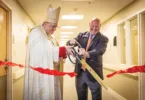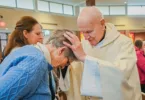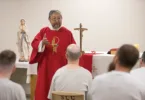Foreign-born priests recall childhoods enriched by the family rosary
by Jill Ragar Esfeld
jill.esfeld@theleaven.org
“No rosary, no dinner. That was the deal.”
And it wasn’t just his family that lived that way, explained Father Reggie Saldanha, who grew up in a Catholic home in the Diocese of Mangalore in southern India.
“Wherever you went in the evening,” he explained, “you had to be back for rosary. Every family had this tradition.”
After the rosary, the children would sing a rich variety of Marian songs, then receive blessings from parents and even older siblings. In that way, the associate pastor of Holy Trinity Parish in Lenexa explained, the rosary became a source of family unity, strength and reconciliation.
“In our neighborhood, if you walked outside at 8 o’clock,” he recalled, “from every house you would hear children singing.”
A global devotion
As the Archdiocese of Kansas City in Kansas anticipates the Global Living Rosary event at Kauffman Stadium on May 25, foreign-born priests serving in the archdiocese are reminded of the rosary traditions of their home countries.
The experience of the Global Living Rosary, they said, will show children here that the same prayers they say at home are being prayed by Catholics of other cultures around the world.
“Maybe we express our faith in different ways, but it is the same faith,” said Father Mauricio Garzon from the Diocese of Zipaquira in Colombia, South America. He serves as associate pastor of All Saints Parish in Kansas City, Kan.
Father Reggie hopes the Global Living Rosary will motivate families to pray the rosary together at home, creating family unity and encouraging vocations.
“Parents have a great role in forming children in this devotion to the Blessed Virgin Mary,” he said. “It doesn’t take much time to say the rosary together; every family can afford 15 minutes.”
Serenading Mary
In Ghana, Africa, home to Father Gabriel Archeampong of Mother Teresa of Calcutta Church in Topeka, it is said the people pray with their minds, bodies and souls.
“That is exactly how we’re supposed to worship God,” said Father Gabriel. “And the people bring that into their love of Mary. In Ghana, they love and venerate her, praying the rosary every day.”
In his hometown, Father Gabriel said that the decades of the rosary are often punctuated with Marian hymns.
This custom of making songs a part of the rosary is common in many cultures. Father Jerry Arano-Ponce, pastor of St. Philip Neri Parish in Osawatomie, Sacred Heart in Mound City, and Our Lady of Lourdes in La Cygne, said that is also a tradition in his home country of Mexico.
“It is beautiful, like serenading the Blessed Mother,” he said.
Father Jerry has fond childhood memories of praying the rosary —both as a community in the church and as a family. The devotion reminds him of his paternal grandmother, in particular, who taught him how to pray the rosary.
“Her name was Ester, and I remember her praying the holy rosary at night. And when she came to visit, she would ask us, ‘Are you praying the rosary?’” he recalled. “And then she would invite us all to join her in praying the rosary.”
Father Jerry said that one thing he missed when he came to the United States five years ago is his country’s tradition of finishing the rosary with the Litany of the Blessed Virgin.
“It’s what I love most about the holy rosary and remember with great delight from my childhood back in Mexico,” he said. “I love to hear the litany with all the beautiful titles of honor to the Blessed Mother and to think, ‘She is the mother of Jesus and my mother, too.’”
Like Father Jerry, Father Mauricio credits his grandmother with teaching him the rosary. But the devotion only became a daily practice when he was in the minor seminary.
“I needed to have a good grade for Spanish,” he recalled. “I told the Virgin Mary, ‘Could you please help me? If I pass my studies very well, I promise to pray the rosary every day.’”
“She helped me,” he recalled, “and now I pray the rosary every day.”
Father Mauricio believes Mary has helped him sustain his vocation — with a lot of help from the many people who pray the rosary for him, especially his mother.
“My mother prays three rosaries every day,” he said. “She says that one is for me.”
Mary’s special days
For these priests from around the world, the rosary is inextricably linked to the celebrations of Marian feast days.
Father Reggie’s favorite tradition from India involves a rosary novena preceding the feast of the birth of Mary on Sept. 8.
Each evening of the novena, children gather fresh flowers in baskets. They’ll carry these to school the next morning, sometimes walking two or three miles. They arrive at school an hour early so they can attend Mass and participate in the novena devotion in front of a Marian grotto.
“We would sing songs and then throw the flowers at the Virgin Mary,” Father Reggie recalled.
And sometimes, he admitted, the boys would stand to the back and throw flowers at the girls.
“Then the priest would put the boys up front and the girls at the back,” he said. “So then we would be throwing flowers backwards.”
In Southern India, Mary’s birthday is also known as “The Feast of the Harvest.” Part of the celebration, therefore, involves blessing the first fruits of the harvest, usually rice paddy, and gathering with family for a big meal. Even out-of-town family members travel home for the festivities.
“In September I will be receiving a letter from home with the blessed grains of paddy inside the envelope,” said Father Reggie.
In Ghana, Marian feast days are often commemorated with long pilgrimages to various shrines. A favorite in Father Gabriel’s memory is a procession to St. Mary’s Grotto in the town of Buoho on the feast of the Assumption.
“People walk from the center of the city and recite the rosary while they are also carrying the statue of Mary and singing songs praising Mary for her part in the salvation history,” he said.
His Mexican heritage has given Father Jerry a deep devotion to Our Lady of Guadalupe and rich memories of her feast day celebrations on Dec. 12.
Nine days prior to the feast day, Catholics in Mexico pray rosaries and make a pilgrimage to the churches to pray a final rosary.
“I remember the first time my parents took my sister and me on a pilgrimage from our home town to Mexico City and the Basilica of Our Lady [of Guadalupe],” he said. “I was six years old and, when I saw the image of Our Lady of Guadalupe, my heart was filled with love and I remember at that moment saying, ‘Oh, Blessed Mother, I love you and I want to be a priest.’”
The family that prays together
All four men lament the lack of a family rosary tradition in the United States today.
“Indeed we are all very busy, especially families with young children,” said Father Jerry, “but we find time out of our busy schedules to have fun and to watch TV, so I think we can find a few minutes of sacred time for family prayer.”
Father Jerry suggested that families adding a rosary to their daily schedule may find their days seem longer, giving them more time to complete their other tasks.
Proof of the power of the family rosary, all agreed, will be seen in the strengthening of family ties and a renewed interest among children in vocations.
Plus, said Father Jerry, children might learn the value of approaching the Father through the Mother.
“Many times when children want to get something from their dad, they go to their mother because she knows how to persuade the father,” explained Father Jerry. “So it is the same with Mary.
“Many times, of course, we offer our prayers directly to God. But then, just to make sure he hears everything, we go to Mary and say, ‘Blessed Mother, please remind God the Father of these special requests.’”
Father Reggie hopes the Global Living Rosary will be a beginning of more families saying the rosary together.
“The main object of the Global [Living] Rosary is to be a great step toward starting a devotion to the rosary — not just to pray once, but to start that tradition of praying at home,” he said. “I hope many people will participate in this.”
The rosary, he said, is a vital tool in carrying out God’s work.
“Mary’s life of challenges gives me the necessary courage and encouragement I need to face the pastoral challenges and the challenges to my vocation to the priesthood,” he said.
“I always cherished my intimacy with Mother Mary,” he added, “the intimacy that was planted from my very childhood days by my parents.”






